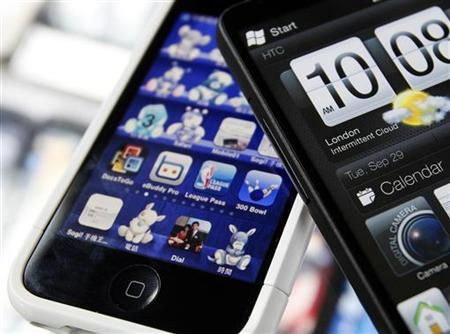Apple (AAPL) iPhone Is Device Of Choice For Shoppers Using Mobiles To Buy Retail, Though Android Mobiles Are Catching Up: IBM Online Retail Index

Apple Inc.’s (NASDAQ:AAPL) iconic iPhone is still the handset of choice for shoppers who buy retail products using their mobile phones, according to the latest International Business Machines Corp. (NYSE:IBM) online retail index from Tuesday.
The index, produced by computing giant IBM, measures retail sales done on online and mobile platforms.
The iPhone captured more mobile traffic than any other mobile device, handling 12 percent of online retail traffic alone -- up almost 50 percent from last year.
Its cousin device, the iPad tablet, placed second, capturing 10.4 percent of mobile traffic. The figures underline Apple’s dominance among tech-savvy consumers, who may own tablets and smartphones, and shop for their clothes or furniture on mobiles.
But cellphones equipped with Google Inc.’s (NASDAQ:GOOG) Android system are fast catching up in this closely watched market. IBM data showed that sales routed via Android mobiles sales grew quickest, with Android handsets absorbing 74 percent more mobile retail traffic over the year before.
Android devices collectively enjoyed 9.5 percent of mobile sales traffic, edging up with only 3 percent less market share than the iPhone.
IBM data doesn’t capture the share of quarterly traffic owned by Samsung Electronics Co., Ltd.’s (KRX: 005935) Galaxy S4 device, the iPhone’s chief high-end rival, said IBM mobile marketing strategist Jay Henderson to International Business Times.
“Certainly we’re seeing Android overall continue to gain market share, but it’s still a little astonishing how dominant Apple is in the traffic and conversions to sales, relative to any other single devices,” said Henderson.
Apple devices definitely dominate relative to, say, their smartphone market share, where iPhones have lost ground to the Galaxy and cheaper smartphones, he added.
The index also showed that mobile-minded U.S. consumers favored home improvement products and department stores most in the third quarter.
Overall online retail sales were up 10 percent over last year. Only 14 percent of consumers shopped retail on their mobiles, though that’s 60 percent more than last year.
That boost is the largest yearly increase since the end of 2012, so consumers may be slowly returning to mobile shopping as a sluggish economic recovery picks up steam.
About a third of online sales were made through mobiles, according to the IBM data, up about 50 percent from 2012.
Although IBM’s index usually accompanies retail surveys from the Department of Commerce, the index is a key lonely dataset for retailers this quarter, given the government shutdown.
Other economic data victims include last week’s monthly unemployment report and U.S. Department of Agriculture reports that impact agricultural commodity prices.
At the end of 2012, the iPad dominated mobile sales, making up more than 35 percent of all mobile sales, according to past IBM data. The iPad traffic tends to spike in the evenings, when people settle down for some casual “couch commerce,” said Henderson.
There are strong business synergies between mobile advertising and mobile shopping, and mobile advertising has been a key concern for social media companies like Facebook and Twitter.
Rising mobile ad revenues were a factor in Facebook Inc. (NASDAQ:FB) shares reaching a record high in late September. Money from mobile advertising is also on the minds of investors keen on Twitter’s imminent $12 billion launch.
© Copyright IBTimes 2024. All rights reserved.






















